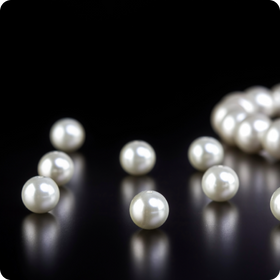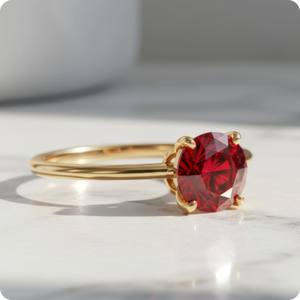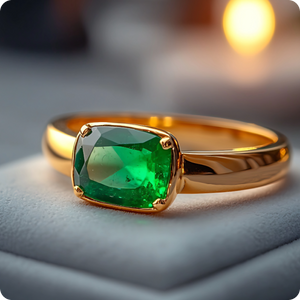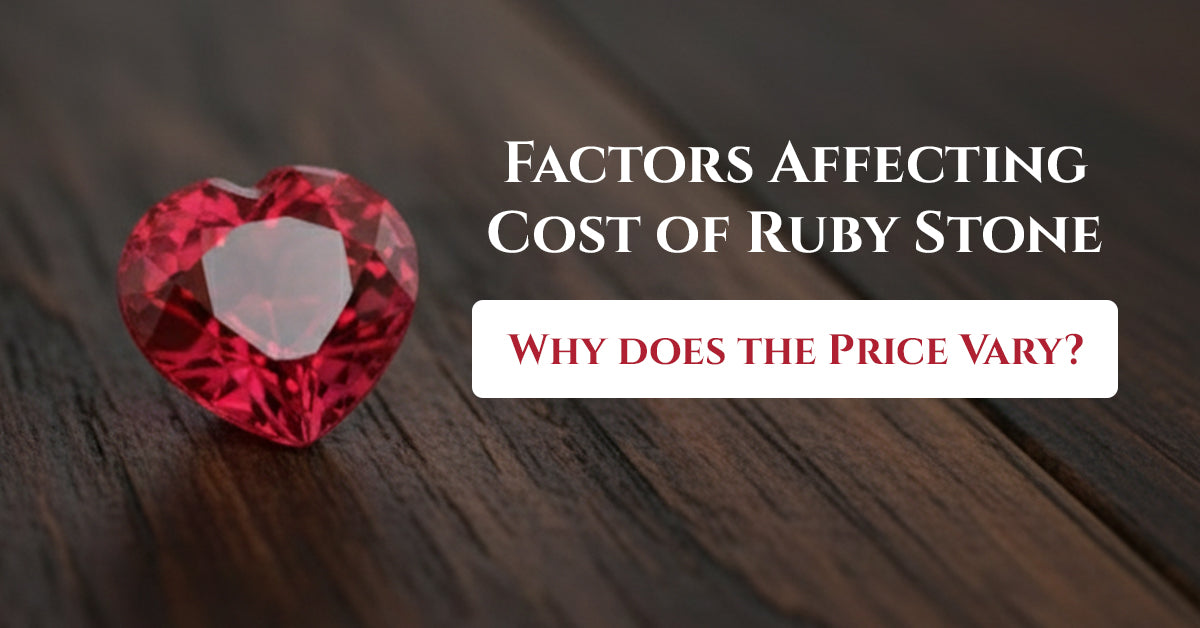Due to its astrological importance and enticing red tint, rubies, also known as Manik stones in India, are among the most sought-after valuable gemstones. However, one question that both buyers and collectors frequently ask is: Why does the price of ruby stone vary so much?
Origin, colour, clarity, cut, and treatment are some of the important aspects that affect the price of ruby stones, which range from rare specimens that cost lakhs to more cheap gems that cost only a few thousand rupees per carat. Being aware of these elements enables you to make well-informed decisions and obtain the most return on your investment.
We'll examine the main variables influencing ruby stone prices in this comprehensive guide, as well as the reasons behind the significant disparity in prices between India and other countries.
In This Blog:
-
Factors Affecting Cost of Ruby Stone
-
Origin of the Ruby Stone
-
Colour: The Heart of a Ruby’s Value
-
Clarity: The Internal Purity of the Stone
-
Cut and Shape: Enhancing Brilliance and Value
-
Carat Weight: Bigger Stones, Exponential Prices
-
Treatments: Natural vs Treated Rubies
-
Certification: Authenticity Matters
-
Market Demand and Astrological Significance
-
Average Ruby Stone Price in India (Approximate Guide)
-
Conclusion
-
FAQs
Factors Affecting Cost of Ruby Stone
There are various factors that determines and affects the cost of manik stone; hence it is essential to understand those factors:
Origin of the Ruby Stone
The provenance of ruby stone is one of the main variables affecting its price. The quality, clarity, and colour of rubies varies depending on where they are produced. Let's examine the most noteworthy beginnings:
1. Burmese (Myanmar) Ruby- The Most Valuable
The best rubies in the world are thought to come from Myanmar, particularly the Mogok Valley. They have an unrivalled brilliance and a vivid, pigeon-blood red hue. Depending on grade, Burmese rubies can fetch prices ranging from ₹1 lakh to ₹10 lakh per carat due to their rarity and beauty.
2. Mozambique Ruby- High Quality, More Affordable
In recent years, Mozambique rubies have become extremely popular. Though more accessible, they exhibit a deep red hue akin to Burmese rubies. Mozambique ruby stones are a popular option for individuals looking for superior quality at a somewhat reduced price, with prices typically ranging from ₹25,000 to ₹1,00,000 per carat in India.
3. Thai Ruby- Deep Red with a Darker Tone
Thai rubies frequently have a redder, more garnet-like hue. Even though they might not be as brilliantly bright as Burmese rubies, jewellery shoppers find them appealing due to their low cost. In India, a carat of Thai ruby stone typically costs between 10,000 and 50,000 rupees.
4. African & Indian Rubies- Budget- Friendly Options
Due to its lower colour intensity and purity, rubies from nations like Kenya, Tanzania, and India are comparatively less expensive. These are excellent substitutes for individuals who want the astrological advantages of the Manik stone without going over budget. Each carat might cost anything between ₹2,000 and ₹15,000.
Colour: The Heart of a Ruby’s Value
The most important factor influencing ruby stone price is colour. A vibrant, pure red with faint blue undertones often referred to as "pigeon blood red" is the perfect ruby colour.
Key Colour Attributes Affecting Ruby Price:
- Hue: The ruby's primary colour (pure red as opposed to orangish-red or purplish red).
- Tone: Medium to medium-dark hues are said to have the best colour depth.
- Saturation: The red color's intensity or vibrancy.
Overly bright or dark-coloured rubies are typically less costly. For example, even if other quality factors are comparable, a bright, saturated red ruby may cost up to ten times as much as a pale or very dark one.
As a result, while determining the price of Manik stone, gemologists frequently start by examining colour.
Clarity: The Internal Purity of the Stone
Rubies have intrinsic defects or natural inclusions, just like other gemstones. The creation of the gemstone under intense heat and pressure is what led to these inclusions.
- Very rare and valuable are high-clarity rubies, or those with little obvious inclusions.
- The majority of purchasers may afford somewhat including rubies, which are typical.
- Significantly less expensive are heavily included rubies, particularly those with obvious fissures or dark areas.
Because entirely inclusion-free rubies are practically nonexistent, a ruby with dazzling clarity and few inclusions will typically fetch a higher price.
While a similar ruby with mild inclusions may cost between ₹50,000 and ₹1 lakh per carat, an excellently clear Burmese ruby might cost over ₹2 lakh.
Read Also - Ruby Gemstone Price Guide
Cut and Shape: Enhancing Brilliance and Value
The cut of a ruby has a direct impact on its overall value, brilliance, and aesthetic appeal. Cutters strive to maintain the maximum carat weight while enhancing the gem's beauty because rubies are naturally rare and costly.
Typical Ruby Cuts:
- Oval Cut: The most common cut for jewellery, it enhances brilliance.
- Cushion Cut: A traditional shape that keeps colour vibrancy.
- Round Cut: Beautiful to look at, but less common because of considerable waste.
- Cabochon Cut: For asterism-displaying star rubies.
A well-cut ruby can look more vibrant and livelier, which will increase its value. Even rubies with outstanding colour can have a lacklustre appearance due to poor cutting, which lowers their market value.
For example, depending on how beautifully the gemstone is cut and polished, the price of a ruby stone in India can rise by 20% to 30%.
Carat Weight: Bigger Stones, Exponential Prices
The cost of a ruby per carat rises disproportionately with size, as is the case with all gemstones. Particularly when they retain exceptional colour and purity, large rubies (over 2–3 carats) are much uncommon than smaller ones.
For instance:
- Each carat of a quality Burmese ruby might cost ₹1 lakh.
- A 3-carat size of the same grade may cost between ₹3 and ₹5 lakh per carat.
The scarcity of larger rubies with the same superior qualities is the cause of this exponential price increase.
Treatments: Natural vs Treated Rubies
Another major factor influencing the cost of ruby stone is whether it’s treated or natural (untreated).
1. Heat Treated Rubies
To improve colour and clarity, the majority of rubies sold on the market undergo heat treatment. The technique enhances their visual appeal even if these are real rubies. Depending on quality, heat-treated rubies can cost anywhere from ₹10,000 to ₹1 lakh per carat, making them reasonably priced.
2. Unheated Natural Rubies
Because they are so uncommon, unheated rubies are highly valued in the gemstone industry. Both astrologers and collectors value these stones highly. Top-quality rubies from Burma or Mozambique can cost anywhere from ₹2 lakh to ₹10 lakh per carat in India.
3. Glass-Filled or Composite Rubies
Lead-glass filling is used to make certain rubies to enhance their colour and transparency. Despite their aesthetic attractiveness, these stones are much less valuable and less resilient. They are not advised for astrological reasons and often cost less than ₹5,000 per carat.
Certification: Authenticity Matters
Synthetics and imitations are common in the gemstone market. A certified ruby from a reputable gemological lab guarantees genuineness and supports the cost.
Credentials from reputable laboratories like GIA, IGI, or GRS attest to information such as:
- Origin: natural or artificial.
- Status of treatment.
- Clarity, cut, and carat weight.
Investing in a certified ruby protects your money and gives your insight into the going rate for your gem in India.
Market Demand and Astrological Significance
Particularly in India, the astrological demand for rubies has a big impact on their price. The Manik stone, which is connected to the Sun (Surya), is thought to bestow upon its bearer wealth, renown, and leadership.
The price of Manik stone tends to increase at favourable times, like wedding seasons or solar transits, because of increased demand. In a similar vein, a shortage of supply from Mozambique or Myanmar may likewise raise prices in the Indian market.
Average Ruby Stone Price in India (Approximate Guide)
Here is a list of an average ruby stone price in India according to their origin:
|
Type/ Origin |
Quality |
Average Price Range (per carat) |
|
Burmese Ruby |
Top Quality |
₹1,00,000 – ₹10,00,000+ |
|
Mozambique Ruby |
Premium Grade |
₹25,000 – ₹1,00,000 |
|
Thai Ruby |
Medium Quality |
₹10,000 – ₹50,000 |
|
African/ Indian Ruby |
Commercial Quality |
₹2,000 – ₹15,000 |
|
Glass Filled Ruby |
Low Quality |
₹500 – ₹5,000 |
Conclusion
A number of natural, aesthetic, and commercial elements influence the price of ruby stones; carat weight, cut, colour, clarity, provenance, and treatment are all important considerations. By being aware of these subtleties, buyers in India may be sure they are paying a reasonable amount for genuine and high-quality rubies.
When you think of buying ruby stone online, make sure you are working with a reliable platform such as GemsRoot that has lab-certified gemstones, worldwide shipping, and transparent and unmatched prices. You’ll get all the varieties at a reasonable price with proper guidance and quality assurance. You can contact us at +91 114-314-8316. We also offer consultation for a better understanding of what to wear and how to purchase the stone. Contact us to know more!
FAQs
1. Why does the cost of ruby stone vary so much?
The origin, colour intensity, clarity, carat weight, and treatment all affect how much a ruby stone cost. Compared to treated or inferior rubies, premium Burmese or unheated rubies are substantially more expensive.
2. What is the average cost of ruby stone in India?
Depending on colour, clarity, and certification, ruby stones in India can cost anywhere from ₹2,000 per carat for commercial quality to over ₹10 lakh per carat for premium Burmese rubies.
3. How is the cost of Manik stone calculated?
Manik stone's carat weight, natural origin, treatment status, and colour richness are all taken into account when determining its price. Vibrant red rubies with outstanding clarity that aren't heated get the greatest prices on the market.
4. Why are Burmese rubies more expensive than other rubies?
Known for its exceptional transparency and striking pigeon-blood red hue, Burmese rubies are extremely uncommon. They are the costliest rubies in the world and are widely valued in India due to their rarity and unparalleled quality.
5. How can I identify if a ruby is worth its price?
Verify gemstone certification, natural origin, colour consistency, and treatment details to guarantee a fair ruby stone pricing in India. Always purchase from trustworthy vendors that provide authenticity reports from accredited gem labs.

 Emerald (Panna)
Emerald (Panna)
 Ruby (Manik)
Ruby (Manik)
 Yellow Sapphire (Pukhraj)
Yellow Sapphire (Pukhraj)
 Blue Sapphire (Neelam)
Blue Sapphire (Neelam)
 White Sapphire (Safed Pukhraj)
White Sapphire (Safed Pukhraj)
 Hessonite (Gomed)
Hessonite (Gomed)
 Red Coral (Moonga)
Red Coral (Moonga)
 Pearl (Moti)
Pearl (Moti)
 Cats Eye (Lahsuniya)
Cats Eye (Lahsuniya)
 Opal (Dudhiya Pathar)
Opal (Dudhiya Pathar)
 Red Garnet (Rakt Mani)
Red Garnet (Rakt Mani)
 Moonstone (Chandrakant)
Moonstone (Chandrakant)
 Carnelian (Rat-Ratua)
Carnelian (Rat-Ratua)
 Peridot (Mani Stone)
Peridot (Mani Stone)
 Green Onyx (Sulemani)
Green Onyx (Sulemani)
 Jade (Crassula)
Jade (Crassula)
 Citrine (Sunela)
Citrine (Sunela)
 Amethyst (Jamunia)
Amethyst (Jamunia)
 Aries (Mesh)
Aries (Mesh)
 Taurus (Vrushabh)
Taurus (Vrushabh)
 Gemini (Mithun)
Gemini (Mithun)
 Cancer (Kark)
Cancer (Kark)
 Leo (Sinh)
Leo (Sinh)
 Virgo (Kanya)
Virgo (Kanya)
 Libra (Tula)
Libra (Tula)
 Scorpio (Vrishchik)
Scorpio (Vrishchik)
 Sagittarius (Dhanu)
Sagittarius (Dhanu)
 January Birthstone
January Birthstone
 February Birthstone
February Birthstone
 March Birthstone
March Birthstone
 April Birthstone
April Birthstone
 May Birthstone
May Birthstone
 June Birthstone
June Birthstone
 July Birthstone
July Birthstone
 August Birthstone
August Birthstone
 September Birthstone
September Birthstone
 October Birthstone
October Birthstone
 November Birthstone
November Birthstone
 December Birthstone
December Birthstone

 Emerald Rings
Emerald Rings
 Yellow Sapphire Rings
Yellow Sapphire Rings
 Blue Sapphire Rings
Blue Sapphire Rings
 Ruby Rings
Ruby Rings
 Red Coral Rings
Red Coral Rings
 Pearl Ring
Pearl Ring
 White Sapphire Ring
White Sapphire Ring
 Amethyst Ring
Amethyst Ring
 Aquamarine Ring
Aquamarine Ring
 Blue Topaz Ring
Blue Topaz Ring
 Silver Jewellery
Silver Jewellery
 Gold Jewellery
Gold Jewellery
 Panchdhatu Jewellery
Panchdhatu Jewellery
 Rose Gold Jewellery
Rose Gold Jewellery
 Platinum Jewellery
Platinum Jewellery



